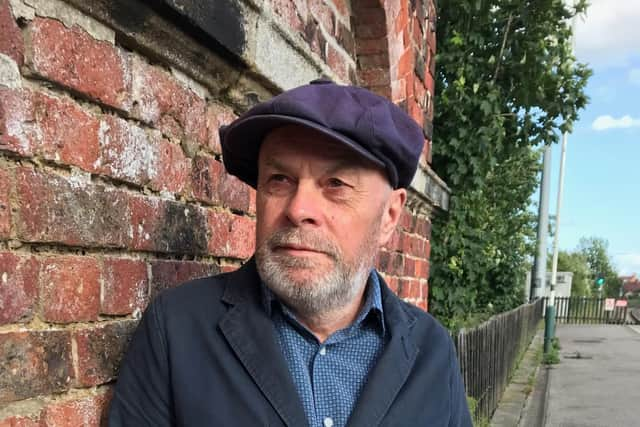Normanton railway station: The Yorkshire railway station which hosted presidents and royalty
What do Queen Victoria, US President Ulysses S Grant, Emperor of Brazil Dom Pedro II and the Prime Ministers Disraeli and Gladstone have in common?
Consider it the most unlikely pub quiz question, one which only former signalman and author David Pendleton could answer: “They all dined at Normanton railway station.”
Advertisement
Hide AdAdvertisement
Hide AdMany other luminaries would have appeared at the West Yorkshire town, too, because before the days of dining cars, Normanton was the lunch stop for Anglo-Scottish express services.


“Everybody who was anybody stopped there. There was a carpet in the first class waiting room, which was £400 in 1876,” says Bradford-born David.
“Today, that's over 50 grand. Mahogany walls, big paintings. You go to Normanton today and you can't even imagine that that happened – but it did.”
Such stories enthuse David, 59, because the railways have always been a big part of his life.
Advertisement
Hide AdAdvertisement
Hide AdOne service in particular, though it came too late to carry Queen Vic et al, has caught his imagination over the years.


The Thames-Clyde Express passenger train ran between 1927 and 1975, covering more than 400 miles of incredible scenery from London’s St Pancras to Glasgow via the shires of England, Leeds and Sheffield, the legendary Settle-Carlisle line and the Scottish borders.
His new book, On the Tracks of the Thames-Clyde Express, is not just about the train itself, but the journey – the places and people in the geography it travelled – with photography courtesy of Gavin Morrison.
Hence, stories of the Normanton luncheons are included, despite happening long before the Thames-Clyde Express itself was in operation.
Advertisement
Hide AdAdvertisement
Hide AdIt was a service that David learned about during his years as a signalman. In his 34 years he worked at Steeton, Shipley, Hellifield, the Calder Valley, Healey Mills and, finally, at Seamer, near where he lives in Filey.


Spending long hours alone, signalmen – they were, at that point, pretty much just men – had to keep themselves entertained (though he stresses that at times it was very busy).
As such, he worked alongside a self-taught violinist, one colleague played the French horn and David had a go at the saxophone.
“But I had to stop because you couldn’t hear the bells ringing,” he says.
Advertisement
Hide AdAdvertisement
Hide AdHis main pastime, though, was reading, and he eventually went into academia, studying at Leeds Metropolitan University and De Montfort University, Leicester.
At Leeds, his Masters dissertation focused on holiday-making patterns on the Yorkshire Coast, with a particular interest in events at Skipsea. Later, he became Doctor of Philosophy at Leicester with a study of commercialised sporting leisure in Victorian Bradford.
“My story, in some respects, is not unusual,” says David. “People end up on weird trajectories because they’ve got the time – or they had the time – and that’s where this book started.
“There was a communal telephone system, we used to call them circuit phones, and you would pick them off. To ring them, it was almost like a Morse code signal for whichever box you wanted to talk to,” says David.
Advertisement
Hide AdAdvertisement
Hide AdDuring the night shifts, when boredom set in, there could be 10 signalmen all conversing from remote locations.
“You could end up chatting to the wee hours and the old boys always returned to this one train – they would always, at some point, talk about the Thames Clyde Express,” he says.
They regaled how it was the “highlight of the day – it was the train. You had to get everything out of the way, you wouldn't dare slow it down, it had to get through”.
“I think in everybody’s imaginations, the people on the train were impossibly glamorous people going to wonderful places and the fact that it passed through little Hellifield, travelling between London and Glasgow, was quite something anyway.”
Advertisement
Hide AdAdvertisement
Hide AdDavid travelled on the service as a youngster, from Leeds to London, but his recollections don’t evoke the glamour of many other’s memories.
“I remember going past a coking works and it was like Dante's Inferno because they were pushing out the used coke and it was glowing still. It seems to be overhanging the train. Clearly it wasn't, but I do remember you could feel the heat through the carriage window. It was brilliant for a nine-year-old, amazing.”
He travelled a lot during his research – he thanks his wife, Jackie – and made use of public records.
“The National Rail Museum in York, their archive is absolutely astonishing. I could spend the rest of my life in there, frankly.
Advertisement
Hide AdAdvertisement
Hide Ad“There’s some fantastic photographs from Gavin Morrison, of near Mirfield, who I met in the 1980s. I allowed him to stand on the balcony of the Shipley-Bingley junction signal box to take a picture of a train. In exchange, he gave me a photograph of what he’d taken and I jokingly said 1988 or whatever it was. I gave him permission to stand on the signal box veranda and it took a long time to get the favour back, but here it is.”
After retiring from the railways, David teamed up with two friends on the Yorkshire Coast – White Lodge Hotel owner Bill Rusling and former food industry recipe developer Will Clarke – to open the Filey Gin Distillery.
It is a far cry from his days as a signalman but he continues to regard his former vocation as being like a family – that’s how he was welcomed onto the railways.
And it was a profession that was suited to a particular type of person.
Advertisement
Hide AdAdvertisement
Hide AdDavid adds: “I never understood whether it attracts odd people or it makes you into one because it was a very isolated lifestyle. People called signal boxes the lighthouses of the land. And it used to be a very apt phrase because when I started, nobody had mobile phones in their pockets. There were no computers in the signal box. We didn’t even have a telephone that you could ring to the outside world, all the telephones or internal.
“At a place like Hellified, which is relatively isolated, when you went to work, you were there and you were cut off from the outside world.”
David was brought up at Wrose, near where he later worked in a signal box between Shipley and Bingley.
“It was the first time I got to see life in all its glory because you're sat on the end of the platform. You see all sorts of interesting things going on, particularly at night.”
Advertisement
Hide AdAdvertisement
Hide AdHowever, he says: “My first love was Hellifield, which is sort of the archetypal country signal box in the middle of nowhere, pitch black in the night. I had a stove in the corner that in the winter I’d get going and it'd be very cosy. Definitely a home from home.
“You would polish all the brasses, you would clean the windows. You had the time to do it, but it was the people I was brought up with. It was very much, you left it how you found it.”
Part of David’s motivation was to record a “lost culture that is receding rapidly,” a social history that had been passed through the generations which he heard in the 1980s.
“You’d get told stories about the Second World War up on the Settle-Carlisle line. You could see Manchester burning, apparently – the red on the horizon, if you were right at the top of the fells. You could hear the planes. They used to fly over the top of Garsdale, for example, on their way to try and find Barrow, for the shipworks there."
On the Tracks of the Thames-Clyde Express by Dr David Pendleton, published by Great Northern Book, is out now, priced £19.99. Available from www.gnbooks.co.uk.